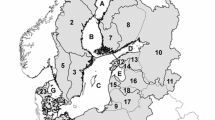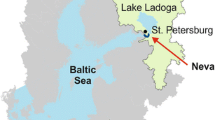Abstract
In this study we evaluate the profitability of nutrient abatement measures in eutrophied coastal areas exposed to a risk of frequent oil spills. The case studied is the Gulf of Finland, which forms part of the Baltic Sea. We present a dynamic model that integrates land loads of nitrogen and phosphorus, cost of nutrient abatement measures in agriculture, nutrient dynamics in the sea basins adjoining the Finnish coast, exogenous risk of oil spills, and recreational value of the sea, which faces environmental damage of uncertain magnitude and duration. Monte Carlo simulation is applied to evaluate the profitability of nutrient abatement measures carried out unilaterally by Finland or as a joint effort by Estonia, Finland and Russia. We demonstrate that a high exogenous risk of oil damage may render investments in nutrient abatement economically infeasible. On the other hand, several components of the model entail uncertainties owing to the scarcity of data and our limited understanding of the relationship between the ecological processes involved and the values people place on natural resources. For example, the uncertainties related to the curvature of the value function outweigh the uncertainties connected with the oil spills and their potential consequences.
Similar content being viewed by others
References
Baltic Nest Institute (2008). Nest, an information environment for decision support system. nest.su.se/nest/ (October 2008).
Brady, M. (2003). The relative cost-efficiency of arable nitrogen management in Sweden. Ecological Economics, 47(1), 53–70.
Brown, C., Corcoran, E., Herkenrath, P., & Thonell, J. (2006). Marine and coastal ecosystems and human wellbeing. Synthesis. UNEP-WCMC, Cambridge, 65 p.
Brown, R. S., & Savage, I. (1996). The economics of double-hulled tankers. Maritime Policy and Management, 23(2), 167–175.
Byström, O. (2000). The replacement value of wetlands in Sweden. Environmental and Resource Economics, 16(4), 347–362.
Carson, R. T., Mitchell, R. C., Hanemann, M., Kopp, R. J., Presser, S., & Ruud, P. A. (2003). Contingent valuation and lost passive use: damages from the exxon valdez oil spill. Environmental and Resource Economics, 25(3), 257–286.
Elofsson, K. (2003). Cost-effective reductions of stochastic agricultural loads to the Baltic Sea. Ecological Economics, 47(1), 13–31.
Etkin, D. S. (2000). Worldwide analysis of marine oil spill cleanup cost factors. Paper presented at Arctic and marine oilspill program technical seminar, June 2000. Available online (March 13, 2009): http://www.environmental-research.com/erc_papers/ERC_paper_2.pdf.
French McCay, D., Rowe, J. J., Whittier, N., Sankaranarayanan, S., & Etkin, D. S. (2004). Estimation of potential impact and natural resource damages of oil. Journal of Hazardous Materials, 107(1–2), 11–25.
Finnish Government (2006). Vesiensuojelun suuntaviivat (Guidelines for water protection November 26, 2006, in Finnish).
Grau, M. V., & Groves, T. (1997). The oil spill process: the effect of coast guard monitoring on oil spills. Environmental and Resource Economics, 10(4), 315–339.
Gren, I.-M. (2001). International versus national actions against nitrogen pollution of the Baltic Sea. Environmental and Resource Economics, 20(1), 41–59.
Gren, I.-M. (2008). Adaptation and mitigation strategies for controlling stochastic water pollution: an application to the Baltic Sea. Ecological Economics, 66(2–3), 337–347.
Gren, I.-M., Destouni, G., & Scharin, H. (2000). Cost effective management of stochastic coastal water pollution. Environmental Modeling and Assessment, 5(4), 193–203.
Grigalunas, T. A., Anderson, R. C., Brown, G. M., Congar, R., Meade, N. F., & Sorensen, P. E. (1986). Estimating the cost of oil spills: lessons from the Amoco Cadiz incident. Marine Resource Economics, 2, 239–262.
Haab, T. C., & McConnell, K. E. (2003). Valuing environmental and natural resources. The econometrics of non-market valuation. Cheltenham: Edward Elgar.
Hart, R., & Brady, M. (2002). Nitrogen in the Baltic Sea—policy implications of stock effects. Journal of Environmental Management, 66(1), 91–103.
Hausman, J. A., Leonard, G. K., & McFadden, D. (1995). A utility-consistent, combined discrete choice and count data model Assessing recreational use losses due to natural resource damage. Journal of Public Economics, 56(1), 1–30.
Helcom (2003). The review of more specific targets to reach the goal set up in the 1988/1998 Ministerial Declarations regarding nutrients. Baltic Sea Environment Proceedings, No. 89, http://www.helcom.fi/stc/files/Publications/Proceedings/bsep89.pdf.
Helin, J., Laukkanen, M., & Koikkalainen, K. (2006). Abatement costs for agricultural nitrogen and phosphorus loads: a case study of crop farming in south-western Finland. Agricultural and Food Science, 15(4), 351–374.
Hoel, M. (1991). Global environmental problems: the effects of unilateral actions taken by one country. Journal of Environmental Economics and Management, 20(1), 55–70. http://www.helcom.fi/stc/files/Publicaions/Proceedings/bsep89.pdf
Hyytiäinen, K., Ahtiainen, H., Heikkilä, J., Helin, J., Huhtala, A., Iho, A., Koikkalainen, K., Miettinen, A., Pouta, E., & Vesterinen, J. (2009). Integrated simulation model to evaluate national policies for agricultural nutrient abatement in the Baltic Sea. Agricultural and Food Science, 18(3–4), 440–459.
Kataria, M., Elofsson, K., & Hasler, B. (2010). Distributional assumptions in chance-constrained programming models of stochastic water pollution. Environmental Modeling and Assessment, 15(4), 273–281.
Keohane, N., Van Roy, B., & Zeckhauser, R. (2007). Managing the quality of a resource with stock and flow controls. Journal of Public Economics, 91(3–4), 541–569.
Kim, I. (2002). Ten years after the enactment of the oil pollution act of 1990: a success or a failure. Marine Policy, 26(3), 197–207.
Laukkanen, M., & Huhtala, A. (2008). Optimal management of a eutrophied coastal ecosystem: balancing agricultural and municipal abatement measures. Environmental and Resource Economics, 39(2), 139–159.
Loureiro, M. L., Ribas, A., Lopez, E., & Ojea, E. (2006). Estimated costs and admissible claims linked to the Prestige oil spill. Ecological Economics, 59(1), 48–63.
Loureiro, M. L., Loomis, J. B., & Vázquez, M. X. (2009). Economic valuation of environmental damages due to the Prestige oil spill in Spain. Environmental and Resource Economics, 44(4), 537–553.
Ollikainen, M., & Honkatukia, J. (2001). Towards efficient pollution control in the Baltic Sea: an anatomy of current failure with suggestions for change. Ambio, 30(4), 245–253.
Plourde, C. G., & Yeung, D. (1989). A model of industrial pollution in a stochastic environment. Journal of Environmental Economics and Management, 16(2), 97–105.
Savchuk, O. P. (2005). Resolving the Baltic Sea into seven subbasins: N and P budgets for 1991–1999. Journal of Marine Systems, 56(1–2), 1–15.
Ylitalo, J., Hänninen, M., & Kujala, P. (2008). Accident probabilities in selected areas of the Gulf of Finland. Helsinki University of Technology. Faculty of Engineering and Architecture. Department of Applied Mechanics. TKK-AM-6. http://appmech.tkk.fi/fi/julkaisut/TKK-AM-6.pdf.
van de Wiel, G., & van Dorp, J. R. (2009). An oil outflow model for tanker collisions and groudings. Annals of Operations Research. doi:10.1007/s10479-009-0674-5.
Vesterinen, J., Pouta, E., Huhtala, A., & Neuvonen, M. (2009). Impacts of changes in water quality on recreation behavior and benefits in Finland. Journal of Environmental Management, 91(4), 984–994.
Author information
Authors and Affiliations
Corresponding author
Rights and permissions
About this article
Cite this article
Hyytiäinen, K., Huhtala, A. Combating eutrophication in coastal areas at risk for oil spills. Ann Oper Res 219, 101–121 (2014). https://doi.org/10.1007/s10479-011-0879-2
Published:
Issue Date:
DOI: https://doi.org/10.1007/s10479-011-0879-2




